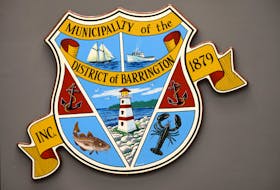
“There appears to be a considerable amount of attention and some work to the rail line that runs through the downtown business core over the last several months,” he said. “But the problem with our rail system is that the standards are too lenient, they are too low.”
Dunn raised concerns about the railroad tracks a year ago, and since that time, inspections have been carried out and some repairs have been made. While he’s pleased that work has been done, he believes the standards for the condition of the railroad need to be updated.
“I’m very happy and pleased a fair bit of attention has been given to the area and I hope they continue to make it as safe as they possibly can,” he said. “They have replaced some rails and some ties here. It’s certainly an improvement, but there’s room for further improvement in making it a safer stretch of rail.”
An assessment of the stretch of tracks running behind Ming’s Restaurant to The Dock carried out by an expert last year found worn rail heads, broken off rail, split and rotting cross ties and spikes that worked their way out of the ties, and at the time Dunn called the condition “deplorable.”
Among his worries about the line is the proximity to the buildings in the downtown area. When he first became concerned, he and a staff member measured the distance between the tracks and some of the buildings, and in some places only 13 feet of space exists.
Dunn said if a derailment occurred, the buildings and people in them would be in jeopardy. “It’s so close to buildings, we couldn’t avoid disaster if it derailed or there was an explosion,” he said.
Cape Breton and Central Nova Scotia Railway owns the tracks and, for their part, Dunn said he believes they’re doing what’s needed. “They’re in compliance, but they (government) certainly need to revisit the standards.”
Although he hasn’t been able to find out how old the regulations are, Dunn believes they were adopted when the cargo carried by trains was less dangerous. He said the trains that travel through New Glasgow often carry volatile freight such as butane and propane, along with more benign goods such as coal.
“I’m urging the federal government to strengthen the safety regulations and practices on the rail lines, especially if they’re carrying any hazardous or dangerous goods.”
He understands that upgrading the standards could be costly for the railway company, but said a dollar figure can’t be placed on safety and human lives.
He’s raised the issue with provincial Transportation and Infrastructure Renewal minister Geoff MacLellan, and last spring a contingent consisting of representatives from that department, town leaders and railway officials walked the tracks. As well, the provincial department arranged an additional Transport Canada inspection, over and above the regular annual inspections for this railway.
TIR communications adviser Brian Taylor said the railroad was found to be in compliance with the regulations. “As with any inspection, the inspectors did note areas for improvement: two locations in the New Glasgow area requiring tie replacement and rail surfacing. The rail company has been doing some scheduled maintenance in these areas.”
Taylor said Nova Scotia’s regulations mirror the national legislation to ensure alignment with other jurisdictions. “They are continually being updated to reflect changes to the federal standards.”
He said the railway company is required to conduct its own track inspections, while Transport Canada ensures they’re carried out. The province also requires railways to have an independent engineer perform a yearly inspection of all structures.
Although aware of Dunn’s worries, Taylor said the province has not identified any areas of concern regarding the regulations to bring forward to Transport Canada.








